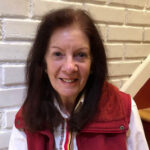Drifting in from the Island’s glacial moraine, spring, traveling on an early morning breeze, announces its arrival as it heads south towards the bay. The vernal tidings, music scored with birdsong, the quacking and peeping of wood frogs and toads as well as a contributing chorus of forest voices enlivens the melody of the ariel drift reaching the outwash plains and deeper into its forest, a remnant of the Long Island Pine Barrens.
There is one particular road that cuts a swath through the outwash forest growing on the plains so that both its sides are bordered by pitch pine and scrub oak trees. The road, named after the Secatogue Native Americans who lived on the Island’s South Shore, offers today’s suburbanites a glimpse into a long ago past. The view from the asphalt speaks of days when the road began as a trail cut open by deer seeking the South Shore’s salt marshes, days long before the Island’s indigenous people hunted and gathered there. Later, colonists lead their livestock along the passage so that their animals might graze on salt marsh hay growing farther south, a pursuit that gradually widened the way.
Along the west side of this road a man and his dog are walking. Their steps fall upon trailing arbutus, better known as mayflower which during early spring matts the sandy glacial soil with its leathery leaves and trumpet shaped flowers. The man and his dog walk peacefully, attune with nature and its tidings. The road I speak of is ongoing, serviceable, taking travelers where they want to go, perhaps more importantly, as in the following case, where they need to go.
A car heading south along this particular route passes the man and his dog. Its passengers, a worried mother and her traumatized six-year-old daughter are on their way to The Center. The Center offers a new form of trauma therapy based on the activity of the body’s polyvagal nerve, a nerve that neurocepts danger and safety in humans and other mammals. Proven successful with helping soldiers and others who have been traumatized, Polyvagal Therapy is now also used in schools helping children deal with a wide range of issues.
On their way to The Center neither mother nor daughter notice the man and his dog as they pass them. They fail to take note of the pine trees with their burly branches softened by their new growth, a growth that dabs touches of vernal green to the cheery blue sky as it they were artists exercising their talent en plein air.
They also fail to see the wing spread of the robin with its cheerful red breast as the bird glides above the road, nor see the mountain laurel’s pink flowers which sparkle like jewels when rays of sunlight fall on their early morning dew touched petals. They miss out on the wonders of spring because their minds are overtaken by worry and anxiety.
When mother and child arrive at The Center, John, a middle-aged man with a kind face and manner meets them at the receptionist’s desk. “Hi, my name is John. I’m going to be helping you. I’m your therapist. Would you like to tell me your names?” he asks.
The child looks up at her mother, for a sign from her that talking to him is ok. Her mother smiles which soothes her daughter. “I’m Jean, and this is my little girl, Linda,” she says.
John shows them to his office and suggests they sit on the couch enabling them to remain close to each other. He recognizes the signs of trauma induced shut down in the child who sits with her head and its mass of curly blond hair turned away from him while her arms reach out for her mother. He waits for them to settle, for the mother’s shoulders to relax and for the child to soften her hold on her mother’s arm. When he senses that they are comfortable with his presence he speaks.
“What brings you to the Center?” he asks. John approaches gently. He has learned that a traumatized person sometimes has difficulty determining safety or danger signals that other people do with ease.
“Her teacher said she isn’t concentrating and at home she just sits around. She doesn’t want to go out and play,” says Jean who speaks through a certain tightness in her throat. It is as if something is holding their story back.
John folds his hands so that they rest quietly on his desk. He looks from child to mother. He asks Jean when it all began. Jean’s voice loosens up a bit, although she worries that she might sound over protective.
“We were in a car accident a few months ago,” she says putting her arm around her daughter. Then In a low voice adding, “she’s afraid, still afraid, of cars. I had a hard time getting her into the car, getting her here.”
John studies the child and considers the nature of her trauma as one of shutdown due to fear. He notes that her eyes are still reluctant to meet his. He watches her as she sinks deeper into her seat with her head still turned away from him. A slight pause between them helps her to relax and finally she turns her eyes on his. While he waited for her attention he considered the course of her treatment.
He then turns to her mother and says, “What we do at The Center is to help people learn how to manage their feelings. How to deal with trauma,” he says while leaning back in his chair. “At this point in time, we won’t talk much about the accident because talking about it until she is ready will only retraumatize her.”
John explains that before they can start therapy, they need to understand that the memory of the trauma will never completely go away because our memories, our experiences are what make us who we are. They can however learn to live with difficult memories without letting them continue to hurt or take time away from having a good life.
Jean listened carefully, nodding her head now and then, a sign that she understood.
“When we feel safe, we feel good,” added John. His eyes remained soft, his voice gentle. “We enjoy life with our family and friends, our thoughts are pleasant. We take in the world in a relaxed way. We feel confident and hopeful. When we don’t feel safe, we feel anxious and worry. We might feel like hiding or fighting and running away.”
“Now while our world is a good world, it’s not always safe. Sometimes bad things happen, like your accident and we might feel that we will never be safe again. We can help ourselves feel better, feel safe. When we know how to help ourselves, we can feel safe again,” he said.
John explained that there was a scientific explanation for what he was saying, but that they didn’t have to know all the science, but that it was helpful to know some.
“You see we have a system inside us called the Autonomic Nervous System,” he said, adding, “I’m going to refer to it as ANS because it’s simpler. The ANS protects us. We have other systems in us, like the digestive system which takes in the food we eat and uses it to make us big and strong,” he said while smiling at Linda. “The ANS takes in the things we experience and helps us feel safe or unsafe. Sometimes when an experience is very hurtful, like the car accident, the ANS gets stuck and we can develop habits of feeling sad, worried and afraid. The ANS can also make things seem worse than what they are so we have to help our nervous system just like when we have a tummy ache, we do something to help us feel better.”
He then asks if they would like to know how they could help themselves feel better.
Linda pushed some of her stray blond curls away from her eyes, swallows, catches her breathe and shyly nods her head.
“Actually, helping yourself can be fun. You need to do things, lots of things that make you feel good. When we feel good the ANS starts to let go of our fears. When we feel good, we feel safe. What are some of the things you both like to do?” he asks.
Linda tells him that she likes to play in the playground and paint pictures. Jean likes to garden and knit.
“Ok, we can start with these and I’m going to add something, an easy breathing technique. You can use it to calm yourself. You breathe in for two counts and then out for four counts. We can work on this before you leave.
John asks what route they took to get to the Center. When he hears it was the one that cut through the Pine Barrens, he suggests that since they both like to spend time outdoors that they stop at the State Park that has its entrance along the road.
“Take a walk in the park with the intention to look carefully at the Pine Barrens trees and flowers,” he says. “We call that mindful walking. Mindless walking is when you walk and don’t purposely notice things.”
“When you get home talk about the things you saw. Perhaps draw pictures of them. Eventually doing this, along with some other things I’ll teach you, will help shift the memory of the car accident further from your thoughts. This will help move you both from a state of constant fear and worry to one of safety and relaxation. Remember, it’s important to do this practice mindfully. You will feel better and better the more you do and think about nice things. Observing how you feel doing good things will give you proof that you can help yourself to manage your feelings,” he says.
After Jean and Linda left The Center and as they were walking towards their car Jean asked her daughter how she felt. Linda hesitated for a moment, then reached for the car door’s handle and asked with a thoughtful smile if there were any bunny rabbits living in the park.
 Diane Lundegaard is a Polyvagal Enthusiast. The Polyvagal Theory was created by Dr. Stephen Porges. Learn more through the Polyvagal Institute or on the Stuck Not Broken podcast from Justin Sunseri.
Diane Lundegaard is a Polyvagal Enthusiast. The Polyvagal Theory was created by Dr. Stephen Porges. Learn more through the Polyvagal Institute or on the Stuck Not Broken podcast from Justin Sunseri.





















This website has quickly become my go-to source for [topic]. The content is consistently top-notch, covering diverse angles with clarity and expertise. I’m constantly recommending it to colleagues and friends. Keep inspiring us!